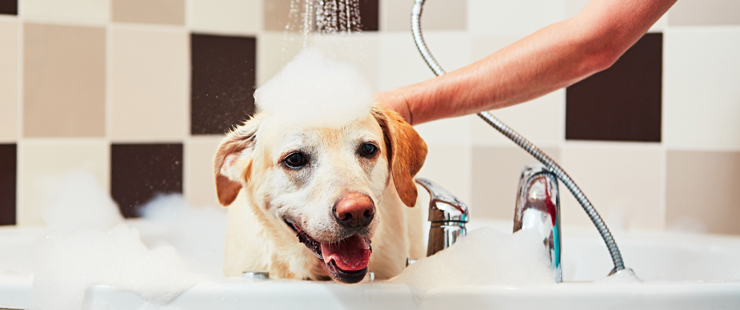My Dog Has Fleas! How to Spot & Kill Them
No matter how diligent we are as pet parents, fleas are an annoying but common concern. These pesky insects can multiply rapidly once they make a home in an animal’s coat, so it’s crucial to act as soon as you notice them on your pup. With the right tools and knowledge, you won’t need to panic the next time you exclaim, “Help, my dog has fleas!”
We’ve answered all the major questions about where fleas come from, how to identify them, and how you can help keep them from harming your furry friend.
What Are Fleas?

Fleas are tiny, parasitic insects from the order Siphonaptera. And when we say tiny, we mean it; eight adults could line up within the length of a paperclip! While fleas may be difficult to see, you can identify them by their unique, reddish-brown appearance and large back legs. They cannot fly, but they have been known to jump distances of 13 inches, according to Michigan State University. Fleas use this incredible leaping ability to hop onto their host, sucking its blood and potentially laying eggs.
Once a flea jumps aboard a host, many more fleas can soon develop. Female fleas produce an average of 27 eggs per day, and the larvae develop within five to 11 days, according to Texas A&M AgriLife Extension. The sooner you can identify fleas on your dog, the better!
When Is Flea Season?
Fleas can be active throughout much of the year. They tend to emerge when the weather rises above 60°F and humidity is over 50%. Many states experience these conditions from spring through autumn, and southern states often encounter them year-round. If it’s warm enough for your dog to spend time outside, there’s a good chance it’s also warm enough for fleas to look for hosts.
How Do Dogs Get Fleas?
These pests may sound scary, but knowing how dogs get fleas is an important first step toward keeping them away from your pooch! A flea can jump to a dog from another animal that is already infected, such as a cat, rodent, raccoon, or another dog. That’s why it’s important to isolate your furry friend if they acquire fleas, as close contact can spread these insects to other mammals—including people.
Dogs can also catch fleas directly from their natural environment. Fleas prefer to reside in shady spots near tall grass, waiting to hitch a ride along the first unlucky animal that passes by. Never underestimate a flea’s ability to find a host; adult fleas detect body heat, movement, vibrations caused by movement, and breathing, according to the Centers for Disease Control and Prevention.
➔ RELATED: Flea and Tick Control for Dogs
What Are Common Signs of Fleas?

While fleas themselves are hard to see, there are several easy-to-spot signs your dog has fleas.
Excessive scratching: Flea bites cause an itchy sensation that will likely have a pup scratching wherever the insects are present. Some dogs are allergic to fleas’ saliva, and even a single bite can lead to an extremely itchy feeling all over their body.
Hair loss: When dogs keep scratching in the same spot, they may pull out their own hair. A cone is an effective way to protect infected furry friends against themselves, limiting their ability to rip away patches of fur.
Skin inflammation: Similarly, excessive scratching can lead to skin inflammation. Dogs who are allergic to flea bites may also experience flea allergy dermatitis, a reaction that causes rashes, bleeding, skin crusting, and scaling.
Discolored gums: Fleas can drink so much blood that they leave their host with an insufficient amount of red blood cells, according to Wag! Known as anemia, this condition can cause a dog’s gums to turn pale. Some less obvious signs of anemia include lethargy, rapid breathing, and dark-colored stools. Consult your veterinarian immediately if you suspect your dog is anemic.
How Can I Spot Fleas on a Dog?

If you know what to look for, finding fleas will be simple. A telltale sign of their presence is “flea dirt,” a dark substance made from flea feces that looks like pepper. Flea dirt is often found on an infected animal’s skin and won’t be hard to identify. To confirm that any specks on your dog are indeed flea dirt, simply remove a few and place them on a wet paper towel. If they are pieces of flea dirt, they will turn red. You can also locate flea dirt on your dog’s bed, the carpet, or anywhere else your pup spends a significant amount of time.
Fleas themselves can be found on your dog’s skin. Look for these reddish-brown insects in areas where fur is especially thick, such as the back of the rear legs, bottom of the tail, neck and collar, belly, inner thighs, and shoulders. Fleas are very sensitive to light and will likely hide in these spots to keep themselves covered.
Don’t forget to look for flea eggs, too. These white ovals are about the size of a grain of sand and easy to miss at first glance, but a close inspection of your dog’s skin can reveal them. Make sure you wash your hands thoroughly after checking your furry friend for fleas!
How Do I Get Rid of Fleas on a Dog?
While no pet parent wants their dog to contract fleas, the good news is that there’s a multitude of ways to combat them! Discover how to get rid of fleas on a dog effectively.
Treat your dog with flea medications: From over-the-counter topical applications to prescription flea medications, learning how to get rid of fleas on a dog is simple with these reliable options. Some treatments attack adult fleas and their larvae, while others only target unhatched eggs without harming the adult flea population. While flea collars are a popular choice for repelling and killing fleas, some may have high pesticide levels that can harm your pet. Talk to your veterinarian to determine the best treatment plan for your dog.
Use a flea comb: This tool is ideal for removing fleas and their eggs without chemicals. Simply run the dog flea comb through your pup’s coat and let its tightly placed teeth catch fleas and debris. Check the comb for fleas frequently and dunk it in a bucket of hot, sudsy water to remove the fleas. As a bonus, you can also use a flea comb to help remove ticks, dandruff, tangles, and mats.
Offer warm baths: Washing away fleas is a great way to keep your furry friend healthy while bonding together. Simply give your dog a bath and use a special shampoo that’s specifically made to kill fleas. Grooming your dog with a flea comb after bath time can offer even more protection!
How Can I Prevent Fleas?

The simplest way to stop fleas from hopping on your dog is to keep their environment under control. Mow your lawn frequently and get rid of yard clutter to eliminate shady spots where fleas love to hide. If your yard is not fenced in, consider putting up a fence to keep away stray animals that can potentially carry fleas onto your lawn.
Some indoor maintenance will also go a long way toward keeping your dog and home protected. Vacuum regularly, especially in your pup’s favorite hangout spots like their bed and crate. You should also bathe and groom your dog as needed, as well as wash their belongings frequently. Inspect your dog and home for fleas often; the sooner you find fleas, the easier they will be to eradicate!
Check out our dog flea prevention article for more advice on keeping these parasites away.
Here’s to a Flea-Free Furry Friend
With some perseverance and dedication, you can knock out fleas and reduce their chance of coming back. Keep following our prevention and removal tips, and you won’t be saying, “My dog has fleas!” anymore.









